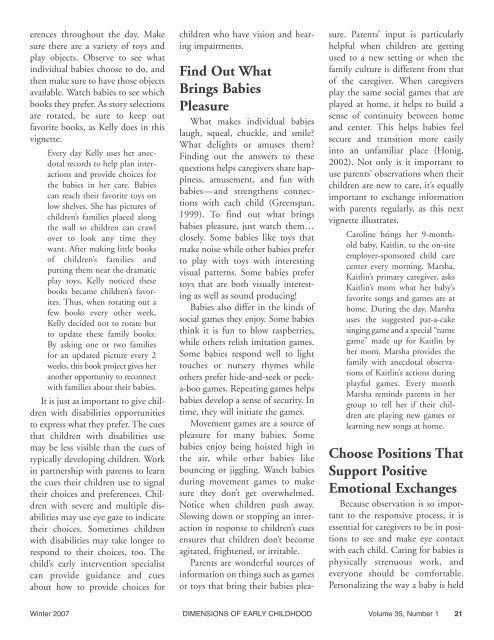Dimensions of Early Childhood - Southern Early Childhood ...
Dimensions of Early Childhood - Southern Early Childhood ...
Dimensions of Early Childhood - Southern Early Childhood ...
You also want an ePaper? Increase the reach of your titles
YUMPU automatically turns print PDFs into web optimized ePapers that Google loves.
erences throughout the day. Make<br />
sure there are a variety <strong>of</strong> toys and<br />
play objects. Observe to see what<br />
individual babies choose to do, and<br />
then make sure to have those objects<br />
available. Watch babies to see which<br />
books they prefer. As story selections<br />
are rotated, be sure to keep out<br />
favorite books, as Kelly does in this<br />
vignette.<br />
Every day Kelly uses her anecdotal<br />
records to help plan interactions<br />
and provide choices for<br />
the babies in her care. Babies<br />
can reach their favorite toys on<br />
low shelves. She has pictures <strong>of</strong><br />
children’s families placed along<br />
the wall so children can crawl<br />
over to look any time they<br />
want. After making little books<br />
<strong>of</strong> children’s families and<br />
putting them near the dramatic<br />
play toys, Kelly noticed these<br />
books became children’s favor -<br />
ites. Thus, when rotating out a<br />
few books every other week,<br />
Kelly decided not to rotate but<br />
to update these family books.<br />
By asking one or two families<br />
for an updated picture every 2<br />
weeks, this book project gives her<br />
another opportunity to reconnect<br />
with families about their babies.<br />
It is just as important to give children<br />
with disabilities opportunities<br />
to express what they prefer. The cues<br />
that children with disabilities use<br />
may be less visible than the cues <strong>of</strong><br />
typically developing children. Work<br />
in partnership with parents to learn<br />
the cues their children use to signal<br />
their choices and preferences. Children<br />
with severe and multiple disabilities<br />
may use eye gaze to indicate<br />
their choices. Sometimes children<br />
with disabilities may take longer to<br />
respond to their choices, too. The<br />
child’s early intervention specialist<br />
can provide guidance and cues<br />
about how to provide choices for<br />
children who have vision and hearing<br />
impairments.<br />
Find Out What<br />
Brings Babies<br />
Pleasure<br />
What makes individual babies<br />
laugh, squeal, chuckle, and smile?<br />
What delights or amuses them?<br />
Finding out the answers to these<br />
questions helps caregivers share happiness,<br />
amusement, and fun with<br />
babies—and strengthens connections<br />
with each child (Greenspan,<br />
1999). To find out what brings<br />
babies pleasure, just watch them…<br />
closely. Some babies like toys that<br />
make noise while other babies prefer<br />
to play with toys with interesting<br />
visual patterns. Some babies prefer<br />
toys that are both visually interesting<br />
as well as sound producing!<br />
Babies also differ in the kinds <strong>of</strong><br />
social games they enjoy. Some babies<br />
think it is fun to blow raspberries,<br />
while others relish imitation games.<br />
Some babies respond well to light<br />
touches or nursery rhymes while<br />
others prefer hide-and-seek or peeka-boo<br />
games. Repeating games helps<br />
babies develop a sense <strong>of</strong> security. In<br />
time, they will initiate the games.<br />
Movement games are a source <strong>of</strong><br />
pleasure for many babies. Some<br />
babies enjoy being hoisted high in<br />
the air, while other babies like<br />
bouncing or jiggling. Watch babies<br />
during movement games to make<br />
sure they don’t get overwhelmed.<br />
Notice when children push away.<br />
Slowing down or stopping an interaction<br />
in response to children’s cues<br />
ensures that children don’t become<br />
agitated, frightened, or irritable.<br />
Parents are wonderful sources <strong>of</strong><br />
information on things such as games<br />
or toys that bring their babies pleasure.<br />
Parents’ input is particularly<br />
helpful when children are getting<br />
used to a new setting or when the<br />
family culture is different from that<br />
<strong>of</strong> the caregiver. When caregivers<br />
play the same social games that are<br />
played at home, it helps to build a<br />
sense <strong>of</strong> continuity between home<br />
and center. This helps babies feel<br />
secure and transition more easily<br />
into an unfamiliar place (Honig,<br />
2002). Not only is it important to<br />
use parents’ observations when their<br />
children are new to care, it’s equally<br />
important to exchange information<br />
with parents regularly, as this next<br />
vignette illustrates.<br />
Caroline brings her 9-monthold<br />
baby, Kaitlin, to the on-site<br />
employer-sponsored child care<br />
center every morning. Marsha,<br />
Kaitlin’s primary caregiver, asks<br />
Kaitlin’s mom what her baby’s<br />
favorite songs and games are at<br />
home. During the day, Marsha<br />
uses the suggested pat-a-cake<br />
singing game and a special “name<br />
game” made up for Kaitlin by<br />
her mom. Marsha provides the<br />
family with anecdotal observations<br />
<strong>of</strong> Kaitlin’s actions during<br />
playful games. Every month<br />
Marsha reminds parents in her<br />
group to tell her if their children<br />
are playing new games or<br />
learning new songs at home.<br />
Choose Positions That<br />
Support Positive<br />
Emotional Exchanges<br />
Because observation is so important<br />
to the responsive process, it is<br />
essential for caregivers to be in positions<br />
to see and make eye contact<br />
with each child. Caring for babies is<br />
physically strenuous work, and<br />
everyone should be comfortable.<br />
Personalizing the way a baby is held<br />
Winter 2007 DIMENSIONS OF EARLY CHILDHOOD Volume 35, Number 1 21

















